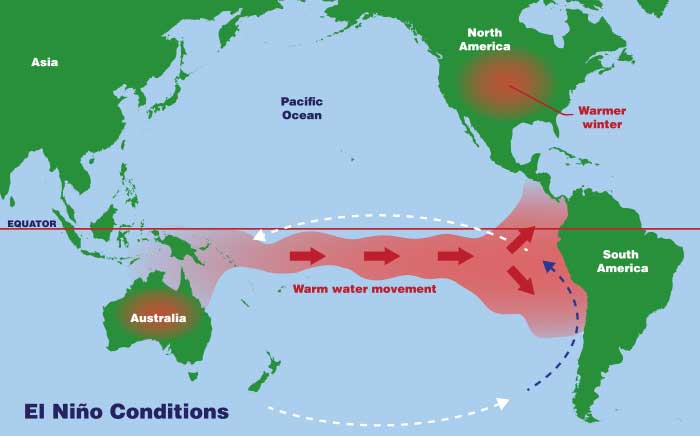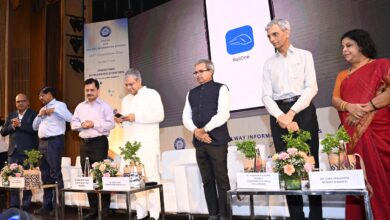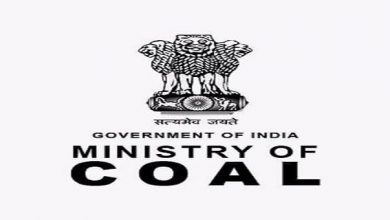Climate Models Predicting El Niño, With Intense Heatwaves And Less Rain This Year
The evolving phase of El Niño coincides with summer Monsoon that spans from June - September

La Nina is all set to bid adieu, with the anomalies of cool temperatures in the Pacific waters are likely to dissolve. According to the latest forecast by NOAA, a transition from La Niña to ENSO-neutral will occur mostly during the February-April 2023 season. This is the first triple dip La Nina of the 21st century, which is also likely to be the longest on record. The Nino indices have already been weakening during the past few weeks. Prediction is that the La Niña is most likely to conclude by the end of Northern Hemispheric winters.
Climate models are predicting a dominating chance of El Niño by the window of May-July 2023. The evolving phase of El Niño coincides with summer Monsoon that spans from June- September.
According to scientists and meteorologists, this is not good news for the upcoming Monsoon season, which in the past has led to some severe droughts during the El Niño years. The four-month long Southwest Monsoon contributes close to 75% per cent to the annual rainfall in India and irrigates over half of India’s agricultural land.
Not only this, El Niño will also lead in increasing the global mean surface temperature as the ocean transfers heat to the atmosphere. This can be touted as a vicious circle wherein it has been already established by several researches that the frequency of extreme El Niño events increases linearly with the global mean temperature, while a rise in its frequency would further warm the world.

The occurrence of three consecutive La Niña in the Northern Hemisphere is a relatively rare phenomena and is known as ‘triple dip’ La Niña. According to statistics, three La Niña events in a row has happened only twice since 1950.These La Niña instances were observed during 1973-1976 and 1998-2001. According to NOAA, the longest La Niña was 37 months, from the spring of 1973 through the spring of 1976. This was followed by 1998-2001, which stayed for over 24 months.
By February-April 2023, most models indicate the return of ENSO-neutral, with a probability of 82%. What is more concerning is the arrival of dreaded phenomena of El Nino. Climate models are predicting potential return to El Niño by May-July, which coincides with summer Monsoon that spans from June- September.

“During a La Niña, the tropical Pacific soaks up heat like a sponge and builds up the warm water volume. This is the warm water that spills across from the western Pacific to the eastern Pacific during an El Niño. Three consecutive years of La Niña means that the warm water volume is fully loaded and it is likely that the system is ready to give birth to an El Niño. Will it be a strong El Niño like the one during 2015-16? We may get some indications in spring itself,” said Raghu Murtugudde, Visiting Professor, Earth System Scientist at IITB and Emeritus Professor at University of Maryland.
By historical standards, to be classified as a full-fledged El Niño or La Niña episode, these thresholds must be exceeded for a period of at least 5 consecutive overlapping 3-month seasons.
Relation between El Nino and Southwest Monsoon El Niño is invariably linked with poor Monsoon performance and has been considered as a threat. According to statistics, about 60% of the time there will be a probability of drought in the country during an El Niño year. Chances of below-normal rain will be 30%, while the prospect of normal rain remains very rare at 10%.
“As for the monsoon itself, if an El Niño state does emerge by summer, then we are more than likely to see a deficit monsoon. A transition from a La Niña winter (which we are in now) to a summer El Niño state tends to produce the largest deficit in the monsoon – of the order of 15%. This implies that the pre-monsoon and monsoon circulations tend to be weaker,” added Dr Murtugudde.
El Niño is not defined by any set rule book that shows the pattern of how it behaves and progresses. For instance, even the strongest El Niño has given normal Monsoon rains of 102% in 1997, while weak El Niño conditions resulted in severe drought in 2004 to the tune of 86%.
If we look back at the statistics from the year 2000 till 2019 there have been four instances of drought years. In 2002 and 2009 the countrywide deficiency was 19% and 22%, respectively, which were considered severe drought years. While in 2004 and 2015 the deficiency stood at 14% each, which was again a drought. There has been only one instance in the last 25 years (1997) that the country saw surplus rain of 2% despite El Niño.
“El Nino forecast is available for the next 9 months. However, model accuracy for the lead times greater than 4 months is generally low at this time. Yet, the past record of El Nino indicated around this time, is a testimony of spoiled southwest monsoon. ENSO forecasts of December 2013 and December 2017 were akin to December 2022. Both these years witnessed sub-par southwest monsoon rainfall leading to moderate drought in 2014 and
near drought in 2018. Earlier, similar patterns in 2003 and 2008 also proved dreadful, defacing Indian monsoon 2004 & 2009, both drought years. The initial projections indicate ENSO building up sharply and El Nino getting augmented rapidly during monsoon. As of now, the principal indicator Nino 3.4 holds ground and negative anomalies still prevail,” said GP Sharma, President – Meteorology and Climate Change, Skymet Weather.
In an El Nino year, MJO and IOD can be the two saviours for Monsoon Under the gloomy scenario of El Nino, the oceanic parameters – MJO (Madden-Julian Oscillation) and IOD (Indian Ocean Dipole) are the two knights in shining armour for the Southwest Monsoon. Both the weather phenomena, if in a positive phase, are variably
related with good Monsoon rains over the country and are known for negating the effect of El Niño up to large extent. However, it is unclear whether that is a robust relation. It is also unclear if an IOD will evolve this year.
MJO is a transient feature that visits the Indian Ocean at least once and maximum up to four times in the four-month long Monsoon season. Meanwhile, IOD which is also known as Indian Nino, is an irregular oscillation of SSTs (Sea Surface Temperatures) wherein the western Indian Ocean becomes relatively warmer and makes the eastern side colder. This also affects the strength of Monsoon over the Indian Subcontinent. A positive phase sees greater than average SST and more precipitation in the western Indian Ocean region, with a corresponding cooling of waters in the eastern Indian Ocean. The negative IOD brings the opposite conditions.
The writer of this article is Dr. Seema Javed, a known Environmentalist, Journalist and Communications Expert




